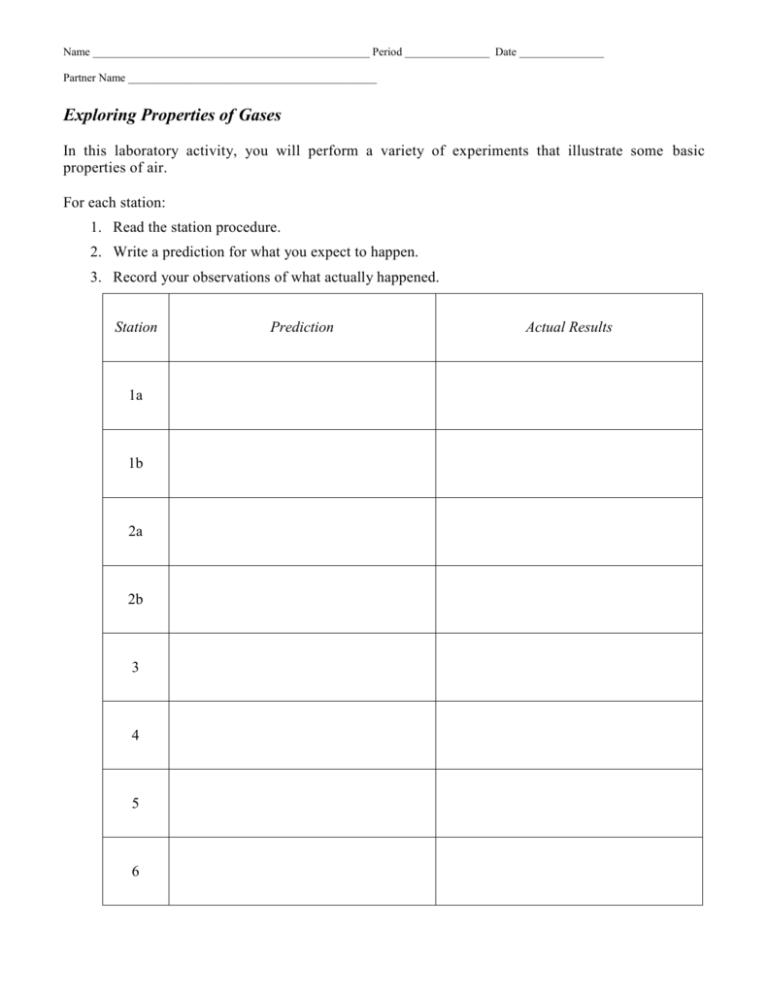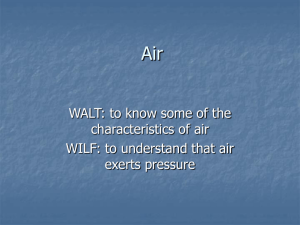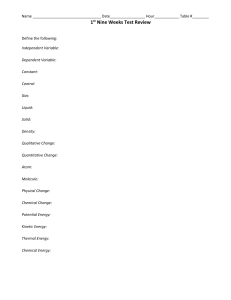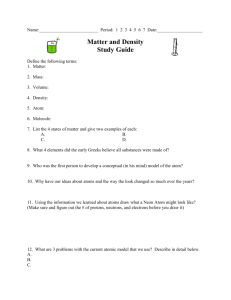Exploring Properties of Gases
advertisement

Name _________________________________________________ Period _______________ Date _______________ Partner Name ____________________________________________ Exploring Properties of Gases In this laboratory activity, you will perform a variety of experiments that illustrate some basic properties of air. For each station: 1. Read the station procedure. 2. Write a prediction for what you expect to happen. 3. Record your observations of what actually happened. Station 1a 1b 2a 2b 3 4 5 6 Prediction Actual Results LAB REPORT For this lab report, turn in the following on separate paper for each station: An explanation of your prediction and the actual results. This may be put into a table. A drawing of what was happening at the station. Drawings should be on the molecular level, showing gas particles. An explanation of the results of the station, and why you obtained specific results. Answers to the following questions: 1. According to the kinetic theory of gases, how do gas particles move? 2. As the temperature of a gas increases, what happens to the volume? 3. Describe one station that provided evidence that there are gas particles around us creating pressure. 4. What do gas particles do that creates pressure? 5. As the temperature of a gas increases, what happens to pressure? 6. As the volume of a gas increases, what happens to pressure? 7. Perform the following activity at home (or in the lunchroom at school): a. Put one end of a straw in a glass of water. b. Hold another straw outside the glass. c. Place the ends of both straws in your mouth and try to drink the water through the straw in the glass. See Figure 3. d. Describe what happens. e. Based on your observations, what makes it possible to drink liquid through a straw? Station 1 – Part A 1. Inflate a balloon and tie the end. 2. Place the inflated balloon on a balance, using a piece of tape to hold it in place. 3. Record the mass. 4. Remove the balloon from the balance. Use a pin to gently puncture the balloon near the neck and release most of the gas contained in it. 5. Place the deflated balloon an a balance (with the tape still attached) and record its mass. Station 1 – Part B 1. Locate the plastic bottle with a small hole in its side. 2. Cover the hole in the side of the bottle with your finger. 3. Fill the bottle with water. 4. Replace the cap tightly. 5. Holding the bottle over a sink, remove your finger from the hole. 6. Still holding the bottle over a sink, remove the cap. Station 2 – Part A 1. With its open end facing downward, lower an empty beaker into a larger container of water. 2. With the open end still under water, slowly tilt the glass. Station 2 – Part B 1. Fill a 100 mL graduated cylinder to the rim with water. 2. Cover the graduated cylinder rim with a piece of plastic. 3. Press on the plastic to make a tight seal with the mouth of the cylinder. 4. While continuing to press the plastic to the graduated cylinder, invert the graduated cylinder above a sink or a pan. 5. Without causing any jarring, gently remove your fingers from the piece of plastic. 6. Repeat the process with the graduated cylinder half-full with water. Station 3 1. Place about 10 mL of water in a clean, empty aluminum soda can. 2. Place the can on a Bunsen burner, and bring the water to a rapid boil. 3. Using beaker tongs, quickly remove the can from the burner and immediately invert it into a container of ice-cold water. Station 4 1. Place 10ml of tap water in a 250ml Erlenmeyer flask. 2. Heat the flask using a hot plate. 3. When the water is almost boiling, remove the flask from the hot plate using hot pads. 4. Tightly secure a balloon over the opening of the flask. 5. Allow the flask to cool. Station 5 1. Place 200ml of tap water in a 250ml Erlenmeyer flask. 2. Place a straw into the opening of the flask. 3. Seal the opening of the flask with clay so that no air can escape around the straw. The only air that should leave or enter the flask is through the straw. 4. When sealed, lightly blow through the straw to check for leaks. 5. If completely sealed, blow as hard as you can for as long as you can (without passing out) through the straw. Station 6 1. Using the bottle labeled “without hole”, insert the rounded end of an unused balloon part way into an empty soft-drink bottle, stretching the balloon's neck over the mouth of the bottle as shown in Figure 1. 2. Blow up the balloon so that it fills the bottle. 3. Using the bottle labeled “with hole”, insert the rounded end of an unused balloon part way into an empty soft-drink bottle, stretching the balloon's neck over the mouth of the bottle. 4. Blow up the balloon so that it fills the bottle. 5. Find the hole in the “with hole” bottle. Cover the hole with your thumb. Blow up the balloon so that it fills the bottle. Figure 1 6. Record your observations. Station 6 – Part B 1. Place a volume of air in the syringe. Cover the syringe opening finger. Push the plunger of the syringe. 2. Place a smaller volume of air in the syringe. Cover the syringe with your finger. Push the plunger of the syringe. 3. Record your observations. with your opening









